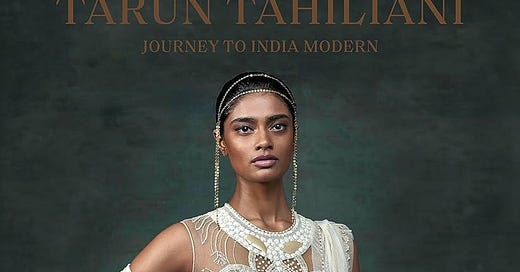Tarun Tahiliani Released A Coffee-table Book & It Was Not What I Expected
Book review of 'Tarun Tahiliani: Journey to India Modern'
When this brick-of-a-coffee table book arrived at my doorstep, I was starstruck. Not by the designer - who is great in his own right - but by the sheer publishing quality of the book. Published by Roli Books, Tarun Tahiliani: Journey to India Modern was released to the world not through a regular book launch, but by a spectacular fashion show with celebrity guests and everything! Such an event for the release of a book is to be expected from such a reputed fashion designer, but normally those books are nothing more than empty self-promotion. My expectations weren’t as high as you’d expect, but I was pleasantly surprised when I started reading the text.
The essays by Alia Allana are simply poetic. Her writing is beautifully descriptive and manages to walk the line between being light as wind and dense as a forest. Every sentence is a treasure of intersection between cultural analysis and Tahiliani’s fashion design documentation. One finds themselves swimming in poetic sentences that aim to do more than simply describe a designer’s work and journey. Allana brought depth into Tahiliani’s already interesting story and made the technical details of garment construction engrossing to read.
Interspersed with archival photographs of Tahiliani’s various collections and press coverage, we get a full view of the life he has lived. The book presents Tahiliani as an extremely self-aware, curious and insightful person with a deep knowledge about the craft of fashion design. It made me want to know him on a deeper, emotional level, and even though this is a purely an archival coffee table book, meant to document his work as a designer, his philosophical side manages to peek in here and there with moving one-liners that I won’t be surprised to find in the future, swimming on the internet, as iconic quotes.
Fashion writing is a niche genre and can often gatekeep people from showing interest in the field by using technical terms and academic language. This creates a mystique around the industry which in turn makes fashion come off as rather intimidating to a layman. This book wasn’t interested in gatekeeping and instead spoke from the heart, aiming to connect emotionally with the reader, citing things and events that most people would relate to. I enjoyed reading the wider cultural perspective Allana took in writing her essays. She zoomed out and looked at where Tahiliani stood in the world at a certain point time in his life. Perfectly crafting the fashion environment and socio-political atmosphere of a time, she brought attention to how his sarees and the various techniques he used in designing clothes, spoke with the culture around him – how he impacted his surroundings and simultaneously, got influenced by his environment.
The book is great documentation of Indian fashion through a Tahiliani lens and if someone is looking for an entry point into the fashion world, I wouldn’t hesitate in recommending this book as a starter.




